
Gasoline Engine
Owner’s Manual
LC152F-1
LC154F-1
LC156F-1


CONTENTS
- 1 -
CONTENTS
1. ENGINE SAFETY........................................................................................2
2. COMPONENTS & CONTROL LOCATIONS…………………………………………3
3. CONTROLS................................. .........................................................4
Fuel cock
Engine switch
Choke lever
Recoil starter
Governor lever
Oil alert
4. CHECK BEFORE OPERATION .............................................................................. 6
Check
Check oil
Check fuel
Check air cleaner
5. STARTING ENGINE........................................................................................................8
6. STOP ENGINE …………………………………………………………………...................10
7. MAINTENANCE ……………………………………………………………………………...11
Schedule
Renewing engine oil
Maintaining air cleaner
Washing sediment cup
Spark plug
Adjusting idle speed
8. STORAGE …………………………………………………………………………………….16
9. TROUBLSHOOTING ………………………………………………………………………...18
10. ENGINE PARAMETER……………………………………………………………………..21
11. WIRING DIAGRAMS………………………………………………………………………..22

ENGINE SAFETY
- 2 -
1. ENGINE SAFETY
IMPORTANT SAFETY INFORMATION
Most accidents with engines can be prevented if you follow all instructions in this manual
and on the engine. Some of the most common hazards are discussed below, along with
the best way to protect yourself and others.
Owner Responsibilities
The engines are designed to give safe and dependable service if operated according
to instructions. Read and understand this owner’s manual before operating the engine.
Failure to do so could result in personal injury or equipment damage.
Know how to stop the engine quickly, and understand the operation of all controls.
Never permit anyone to operate the engine without proper instructions.
Do not allow children to operate the engine. Keep children and pets far away from the
area of operation.
Refuel With Care
Gasoline is extremely flammable, and gasoline vapor can explode. Refuel outdoors, in
a well-ventilated area, with the engine stopped. Never smoke near gasoline, and keep other
flames and sparks away. Always store gasoline in an approved container. If any fuel is
spilled, make sure the area is dry before starting the engine.
Hot Exhaust
The muffler becomes very hot during operation and remains hot for a while after
stopping the engine. Be careful not to touch the muffler while it is hot. Let the engine
cool before storing it indoors.
To prevent fire hazards and to provide adequate ventilation for stationary equipment
applications, keep the engine at least 3 feet (1 meter) away from building walls and
other equipment during operation. Do not place flammable objects close to the engine.
Carbon Monoxide Hazard
Exhaust gas contains poisonous carbon monoxide. Avoid inhalation of exhaust gas.
Never run the engine in a closed garage or confined area.

COMPONENTS & CONTROL LOCATIONS
- 3 -
2. COMPONENTS & CONTROL LOCATIONS
Muffler
Cover
Fuel tank
Throttle
control assy.
Starting lever
Recoil starter
Choke lever
Air cleaner
Spark plug
Cylinder head
cover
Oil alert
Switch
Oil sensor
Oil dipstick
Drain plug

CONTROLS
- 4 -
3. CONTROLS
1) Engine Switch
The engine switch enables and disables the ignition system.
The engine switch must be in the ON position for the engine to run.
Turning the engine switch to the OFF position stops the engine.
2) Choke Lever
The choke lever opens and closes the choke valve in the carburetor.
Set lever “CLOSE” for starting a cold engine.
After starting, set the choke lever to “OPEN” position
3) Recoil Starter Grip
Pulling the starter grip operates the recoil starter to crank the engine.
Don’t let the lever suddenly rebound, lightly put the lever back.
Choke lever
Open
Close
CAUTION
The engine switch
OFF
ON

CONTROLS
- 5 -
4) Governor lever
Adjust the throttle lever position to get required speed.
high low
For proper engine speed, refer to indication provided by equipment.
5) Oil protecting system
The oil protecting system is used for preventing from oil insufficiency in the crankcase,
when oil lowering lower limit, the oil protecting system will automatically make the engine
stopping.(engine still keep the “OPEN” position.)
If automatically stopping and not starting, first, check the oil lever, then, check
other trouble.
Throttle lever
CAUTION
Starter grip

CHECK BEFORE OPERATION
- 6 -
4. CHECK BEFORE OPERATION
1) Check
Look around and underneath the engine for signs of oil or gasoline leaks.
Look for signs of damage.
Check that all shields and covers are in place, and all nuts, bolts, and screws are
tightened.
2) Check oil
When stopping the engine at horizontal place, check the oil
1) Take the oil dipstick and clean
2) Insert the oil dipstick in and check the oil lever without screwing down.
3) If the oil is too low, add the recommenced oil in.
4) After finishing, reassemble and screw the oil dipstick down.
The Oil Alert system (applicable engine types) will automatically stop the engine before the
oil level falls below safe limits. However, to avoid the inconvenience of an unexpected
shutdown, always check the engine oil level before startup.
3) Check fuel
First stop the engine, open the fuel cover, and check oil level., if the oil level is too low, add
the fuel to full, after finishing, screw the fuel cover down.
Don’t add the fuel over the shoulder of the carburetor when fueling (maximum oil level).
Fuel tank volume:
152F-1/154F-1/156F-1-:1.6 L
CAUTION
UPPER OIL LEVEL
LOWER OIL LEVEL
OIL DIPSTICK

CHECK BEFORE OPERATION
- 7 -
Recommended octane rating over 90 unleaded gasoline
For unleaded gasoline, can make carbon deposit muck less and enhance exhaust system
service life
Don’t use used and contaminated or gasoline with oil , Avoid the dirt and water entering
into fuel tank.
4) Check air cleaner
Remove the air cleaner housing and check the element, if the element dirt, clean it, if
damaged, renew.
Nut M6
Air cleaner
elbow
Supporting platee
Element
Cover
Screw
Maximum fuel
oil level

STARTING ENGINE
- 8 -
5. STARTING ENGINE
1) To start a cold engine, move the choke lever to the “CLOSE “position.
To start a warm engine, turn the choke lever to the” OPEN” position.
2) Move the throttle lever away from the “LOW” position, about 1/3 of the way toward the
“HIGH” position.
3) Turn the engine switch to the “ON “position.
ON
Close
Open
Governor lever
Choke lever
The engine switch

STARTING ENGINE
- 9 -
4) Pull the starter grip lightly until you feel resistance, then pull briskly.
Don’t let starting lever suddenly rebound, and lightly put the lever back.
5) If the choke lever has been moved to the “CLOSE” position to start the engine, gradually
move it to the” OPEN” position as the engine warms up.
Choke lever
Open
CAUTION
Starter grip

STOPPING THE ENGINE
- 10 -
6. STOPPING THE ENGINE
To stop the engine in an emergency, simply turn the engine switch to the “OFF” position.
Under normal conditions, use the following procedure.
1). Move the throttle lever to the “LOW” position.
High low
2) Turn the engine switch to the “OFF” position.
OFF
Throttle lever
The engine switch

MAINTENANCE
- 11 -
7. MAINTENANCE
SCHEDULE
REGULAR SERVICE PERIOD
Each
use
First month or
20 Hrs.
Every 3
months or
50 Hrs.
Every 6
months or
100 Hrs.
Every year
or
300 Hrs.
Engine oil
Check
level
○
Change
○
○
Air cleaner
Check
○
Clean
○(1)
Replace
Sediment Cup
Clean
○
Spark plug
Clean
○
Replace
Valve clearance
Check-
Adjust
○(2)
Cover comp head
Clean
After every 300 Hrs. (2)
Fuel tank and fuel
filter
Clean
Every 2 years (Replace if necessary) (2)
Fuel line
Check
Every 2 years (Replace if necessary) (2)
(1)Service more frequently when used in dusty areas.
(2)These items should be serviced by your servicing dealer unless you have the proper
tools and are mechanically proficient.
RENEWING ENGINE OIL
Drain the used oil while the engine is warm. Warm oil drains quickly and completely.
1. Place a suitable container below the engine to catch the used oil, and then remove the
pad and dipstick and the drain plug.
2. Allow the used oil to drain completely, and then reinstall the drain plug and pad, and
tighten it securely.
Please dispose of used motor oil in a manner that is compatible with the environment.
We suggest you take used oil in a sealed container to your local recycling center or
service station for reclamation. Do not throw it in the trash; pour it on the ground; or
down a drain.
3. With the engine in a level position, fill to upper limit with the recommended oil.

MAINTENANCE
- 12 -
Engine oil capacities:
152F-1/154F-1/156F-1: 0.35 L
4) Assembling oil dipstick and screwing down
Recommended oil:
Use 4-stroke automotive detergent oil.
We recommend that you use API SERVICE Category SE or SF oil or equivalent to SG
grade SAE 10W-30.
You can use this brand oil if your area temperature list within some brand oil
temperature range
MAINTAINING AIR CLEANER
A dirty air filter will restrict air flow to the carburetor, reducing engine performance.
If you operate the engine in very dusty areas, clean the air filter more often than specified
in the MAINTENANCE SCHEDULE.
Operating the engine without element or with a damaged element will allow dirt to enter the
engine, causing rapid engine wear.
Drain bolt
Sealing washer
Oil upper limit
Oil dipstick
Environment temperature

MAINTENANCE
- 13 -
Air cleaner
1) Screw off air cleaner bolt and remove the cover.
2) Remove foam element
Check element and renew if damaged.
Wash foam element:
Wash the cover and filter in warm, soapy water, rinse, and allow drying thoroughly. Or
clean in nonflammable solvent and allow drying. Dip in clean engine oil, and then
squeeze out all excess oil.
1. Empty the used oil from the air cleaner case, wash out any accumulated dirt with
nonflammable solvent, and dry the case.
3) Clean the air cleaner l, cover and rubber gasket, preventing dust entering into
carburetor.
4) Reassemble the foam element, paying attention to rubber gasket underneath the
element.
5) Reassemble the air cleaner, and tighten the wing nut securely.
WASHING SEDIMENT CUP
(First check fuel tank for fuel, if having, drain the fuel in the fuel tank completely.)
1. Remove the fuel sediment cup and O-ring.
2. Wash the sediment cup and O-ring in nonflammable solvent, and dry them thoroughly.
Air cleaner elbow
Support plate
Element
Cover
Locking nut
.Nut M6

MAINTENANCE
- 14 -
3. Place the O-ring in the fuel valve, and install the sediment cup. Tighten the sediment
cup securely.
4. Move the fuel valve to the ON position, and check for leaks. Replace the O-ring if there
is any leakage.
SPARK PLUG
Recommended spark plugs: E7RTC or other equivalents.
An incorrect spark plug can cause engine damage.
1. Disconnect the spark plug cap, and remove any dirt from around the spark plug area.
2. Remove the spark plug with a spark plug wrench.
3. Inspect the spark plug. Replace it if the electrodes are worn, or if the insulator is cracked
or chipped. The gap should be 0.028 -0.031 in (0.70 - 0.80 mm). Correct the gap, if
necessary,
O-ring
Sediment cup
Spark plug socket

MAINTENANCE
- 15 -
4. Install the spark plug carefully, by hand, to avoid cross-threading.
5. After the spark plug seats, tighten with a spark plug wrench to compress the water.
If reinstalling the used spark plug ,tighten 1/8 - 1/4 turn after the spark plug seats.
If installing a new spark plug, tighten 1/2 turn after the spark plug seats.
6. Assemble spark plug.
ADJUSTING IDLE SPEED
1. Start the engine outdoors, and allow it to warm up to operating temperature.
2. Move the throttle lever to its slowest position.
3. Turn the idle speed screw to obtain the standard idle speed.
Standard idle speed: 2000±150 rpm
Screw

STORING YOUR ENGINE
- 16 -
8. STORING YOUR ENGINE
If the engine has been running, allow it to cool for at least half an hour before cleaning.
Clean all exterior surfaces, repair any damaged paint, and coat other areas that may rust
with a light film of oil.
Water with big pressure can enter into air cleaner and muffler and even into cylinder along
with air path, resulting in causing rust and water spatter on the hot engine to damage engine,
so don’t wash engine until the engine is cooled.
1) Place a container underneath the carburetor, and use funnel for oil not spattering, close
fuel cock.
2) Remove the drain plug and sediment cup, then, open the fuel cock.
3) Immediately reassemble sediment cup and drain bolt after fuel completely draining.
And screw down.
4) Change the engine oil.
5) Remove the spark plugs.
6) Pour a tablespoon (5-10 cc) of clean engine oil into the cylinder.
7) Pull the starter rope several times to distribute the oil in the cylinder.
8) Reinstall the spark plugs.
9) Pull the starter rope slowly until resistance is felt. This will close the valves so moisture
cannot enter the engine cylinder. Return the starter rope gently.
10) Put the out case on the engine and place in the ventilated and dry area.
·The length of time that gasoline can be left in your fuel tank and
carburetor without causing functional problems will vary with such
factors as gasoline blend, your storage temperatures, and
Spring
Bolt
O-ring
Sediment cup
CAUTION

STORING YOUR ENGINE
- 17 -
whether the fuel tank is partially or completely filled. The air in a
partially filled fuel tank promotes fuel deterioration. Very warm
storage temperatures accelerate fuel deterioration. Gasoline will
oxidize and deteriorate in storage. Deteriorated gasoline will
cause hard starting, and it leaves gum deposits that clog the fuel
system. As a result, If the engine is not used for more than one
month, the fuel oil shall be drained thoroughly to prevent from
deterioration of the fuel in fuel system and carburetor.
·The failures of fuel system or engine performance arising from
improper storage are beyond the scope of the warranty.

TROUBLESHOOTING
- 18 -
9. TROUBLESHOOTING
1) Starting difficult
、
Phenomenon
Possible Cause
Correction
Cylinder
pressure
normal
Spark
plug
normal
Fuel
system
abnormal
Oil path
unpassing
No fuel, oil cock closed
Add fuel, open the
oil cock
Air hole clogged
Clean clogged
Oil cock clogged
wash
Main jet adjusted not
well, or clogged
Readjust, wash
and blow
Needle valve or float
blocked.
Repair or renew
Oil path
passing
Fuel too dirt or
deteriorated
Renew fuel or clear
carburetor
Water in the fuel
Renew fuel and
clean carburetor
Too much fuel in the
cylinder
Drain fuel and
clean spark plug
Wrong fuel
Chang fuel
Fuel
system
normal
Spark
normal
Spark plug
poor
Carbon deposit and dirt
electrode
Clean carbon
deposit and dirt
Damaged insulator
Renew spark plug
Electrode burn through.
Renew spark plug
Wrong gap
Adjust gap
Spark
normal
No spark
High tension coil
damaged
Renew high
tension coil
Igniter coil damaged
Renew high
tension coil
Magnetic field strength
not enough
Charge magnetic
or renew
Cylinder
pressure
abnormal
Fuel
system
normal
Igniter
normal
Spark plug
normal
Piston ring worn or
broken.
Renew
Ring cementation
Clean carbon
deposit
No washer or not
tightening
Add washer or
tighten
Leaking from joint
Renew gasket
valve sealing poor
Lap or renew
Page is loading ...
Page is loading ...
Page is loading ...
Page is loading ...
-
 1
1
-
 2
2
-
 3
3
-
 4
4
-
 5
5
-
 6
6
-
 7
7
-
 8
8
-
 9
9
-
 10
10
-
 11
11
-
 12
12
-
 13
13
-
 14
14
-
 15
15
-
 16
16
-
 17
17
-
 18
18
-
 19
19
-
 20
20
-
 21
21
-
 22
22
-
 23
23
-
 24
24
Ask a question and I''ll find the answer in the document
Finding information in a document is now easier with AI
Other documents
-
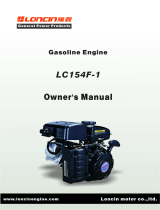 LONCIN LC154f-1 Owner's manual
LONCIN LC154f-1 Owner's manual
-
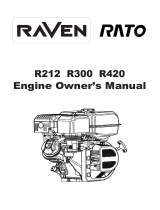 Excell R430 Owner's manual
Excell R430 Owner's manual
-
Hyundai HY25-4 User manual
-
Platinum LATR4000 User manual
-
Champion Power Equipment 100862 Owner's manual
-
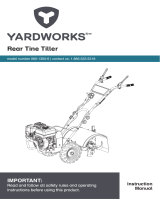 Champion Power Equipment 060-1300-6 User manual
Champion Power Equipment 060-1300-6 User manual
-
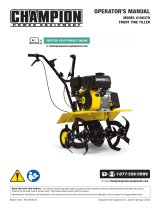 Champion Power Equipment 100379 User manual
Champion Power Equipment 100379 User manual
-
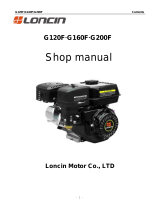 LONCIN G120F Shop Manual
LONCIN G120F Shop Manual
-
DR 5.8 HP Operating instructions
-
Champion Power Equipment Model #100379 User manual




























